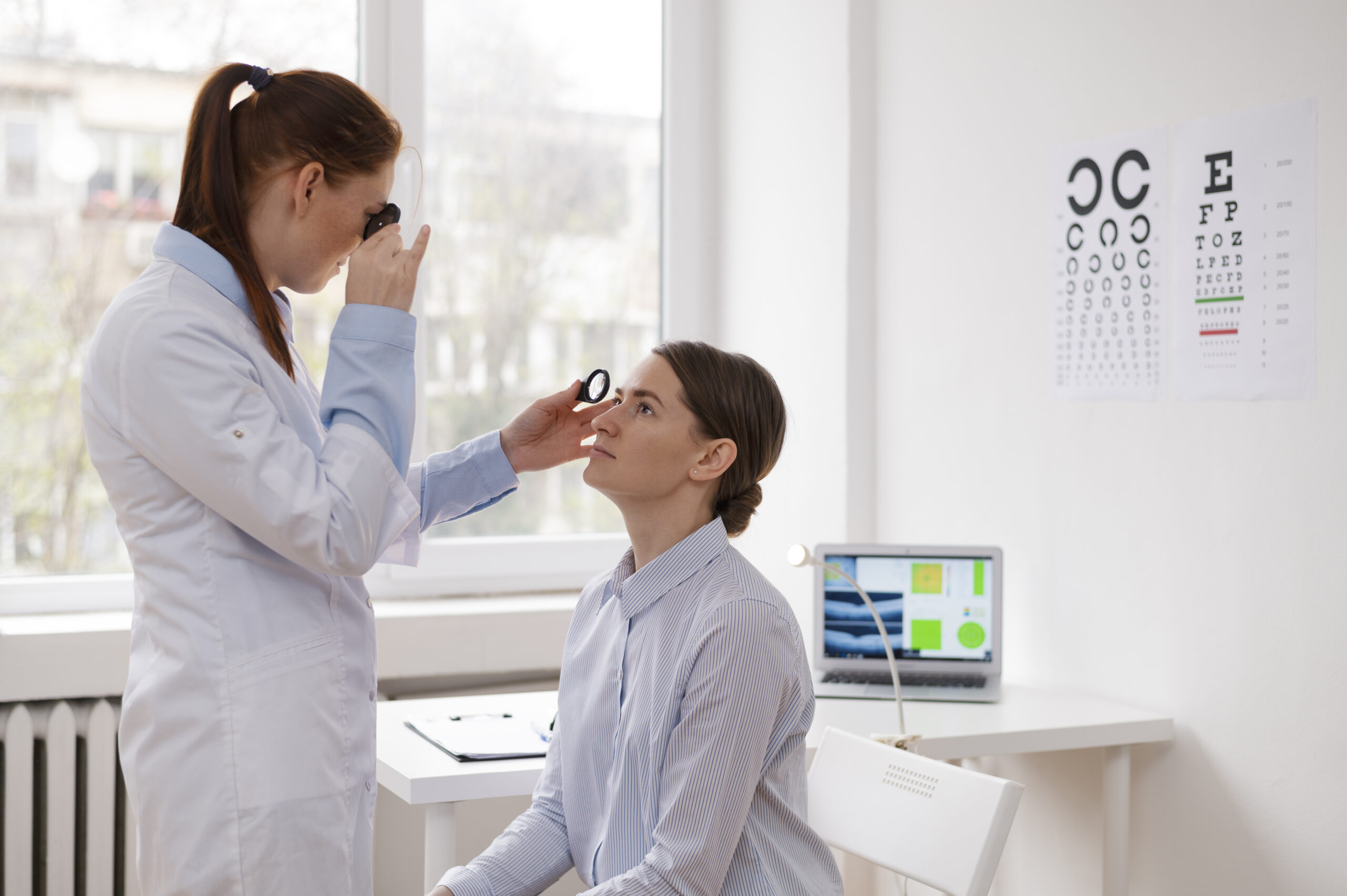Cataracts are a common eye condition, especially as people age. They occur when the natural lens of the eye becomes cloudy, leading to a gradual decline in vision. Cataracts are the leading cause of vision loss worldwide, but the good news is that they are treatable through surgery, allowing most people to regain clear vision.
What Are Cataracts?
A cataract forms when the proteins in the eye’s lens begin to clump together, causing the lens to become cloudy. The lens is responsible for focusing light onto the retina, allowing us to see clearly. As cataracts develop, they can block or scatter light, leading to blurred or dimmed vision.
Cataracts typically develop slowly and can affect one or both eyes. If left untreated, they can lead to significant vision impairment, making everyday activities like reading, driving, and recognizing faces more difficult.
Types of Cataracts
Cataracts can form in different parts of the lens, leading to different types of cataracts:
- Nuclear Cataracts:
- Location: Develops in the central part (nucleus) of the lens.
- Symptoms: May cause a temporary improvement in near vision, often referred to as “second sight,” but this effect diminishes as the cataract progresses. Over time, it can cause the lens to become yellow or brown, distorting color vision.
- Cortical Cataracts:
- Location: Forms in the outer edges (cortex) of the lens and gradually extends towards the center.
- Symptoms: Causes glare, especially at night, and creates a “halo” effect around lights. It may also lead to difficulty with contrast sensitivity.
- Posterior Subcapsular Cataracts:
- Location: Develops at the back of the lens, beneath the lens capsule.
- Symptoms: Progresses more rapidly than other types and can cause difficulty reading, glare, and halos around lights. It often affects vision more when looking at bright lights.
- Congenital Cataracts:
- Location: Present at birth or develops during childhood.
- Causes: May be caused by genetic factors, infections during pregnancy, or other conditions. Early detection and treatment are crucial to prevent vision problems.
Causes and Risk Factors
Several factors can contribute to the development of cataracts, including:
- Age: Cataracts are most commonly associated with aging. By age 80, more than half of all people either have a cataract or have had cataract surgery.
- Genetics: A family history of cataracts can increase the risk.
- Diabetes: People with diabetes are at higher risk of developing cataracts.
- Prolonged Sun Exposure: Excessive exposure to ultraviolet (UV) radiation can increase the risk.
- Smoking: Smoking has been linked to a higher likelihood of developing cataracts.
- Alcohol Consumption: Heavy alcohol use may also contribute to cataract formation.
- Eye Injury or Surgery: Previous eye injuries or surgeries can lead to cataract development.
- Medications: Long-term use of corticosteroids can increase the risk of cataracts.
Symptoms of Cataracts
The symptoms of cataracts can vary depending on the type and stage of the cataract. Common symptoms include:
- Blurry Vision: Vision becomes cloudy or fuzzy, similar to looking through a frosted or fogged-up window.
- Fading or Yellowing of Colors: Colors may appear less vibrant, and it may become difficult to distinguish between similar shades.
- Increased Sensitivity to Light and Glare: Bright lights, headlights, or sunlight may cause discomfort, glare, or halos around lights.
- Poor Night Vision: Difficulty seeing in low-light conditions or at night.
- Double Vision: Seeing multiple images of a single object (usually in one eye).
- Frequent Changes in Eyeglass or Contact Lens Prescription: You may need stronger prescriptions more often than before.
Diagnosis of Cataracts
Cataracts are diagnosed through a comprehensive eye exam, which may include the following tests:
- Visual Acuity Test: Measures how well you see at different distances, using an eye chart.
- Slit-Lamp Examination: A special microscope is used to examine the structures at the front of your eye, including the lens.
- Retinal Exam: After dilating your pupils, your eye doctor examines the retina and lens for signs of cataracts and other eye conditions.
- Tonometry: Measures the pressure inside your eye (intraocular pressure), which can help detect other eye conditions that may coexist with cataracts, such as glaucoma.
Treatment Options for Cataracts
The only effective treatment for cataracts is surgery, which is usually recommended when cataracts begin to interfere with daily activities.
Cataract Surgery
Cataract surgery is one of the most common and successful procedures performed worldwide. During the surgery, the clouded lens is removed and replaced with an artificial lens, known as an intraocular lens (IOL). There are different types of IOLs available, including:
- Monofocal IOLs: Provide clear vision at one distance (near, intermediate, or far). Glasses may still be needed for certain activities.
- Multifocal IOLs: Provide clear vision at multiple distances, reducing the need for glasses.
- Toric IOLs: Correct astigmatism in addition to cataracts.
The surgery is usually performed on an outpatient basis and involves minimal discomfort. Recovery is generally quick, with most people experiencing significant improvement in vision within a few days.
Non-Surgical Management
In the early stages of cataracts, when symptoms are mild, non-surgical options may help manage the condition:
- Stronger Eyeglasses or Contact Lenses: Updating your prescription can help improve vision temporarily.
- Better Lighting: Using brighter lights for reading or other tasks can make it easier to see.
- Anti-Glare Sunglasses: Wearing sunglasses that reduce glare can help manage sensitivity to light.
- Magnifying Lenses: Magnifiers can help with reading or other close-up tasks.
Prevention and Lifestyle Tips
While cataracts cannot be completely prevented, certain lifestyle changes may help reduce the risk or delay their onset:
- Protect Your Eyes from UV Light: Wear sunglasses that block UV rays when outdoors.
- Maintain a Healthy Diet: A diet rich in antioxidants, such as vitamins C and E, may help protect your eyes.
- Quit Smoking: Smoking is a significant risk factor for cataracts.
- Control Diabetes: If you have diabetes, keep your blood sugar levels under control.
- Limit Alcohol Consumption: Reducing alcohol intake may help lower the risk.
Conclusion
Cataracts are a common and treatable condition, especially in older adults. Regular eye exams are essential for early detection, and if cataracts begin to affect your quality of life, cataract surgery can restore clear vision. By understanding the symptoms, risk factors, and treatment options, you can take proactive steps to maintain your eye health and enjoy clear vision as you age. If you notice any changes in your vision, it is important to consult with your eye care professional for a comprehensive evaluation.
For more info, download our detailed brochure here.



